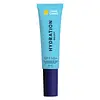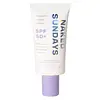What's inside
What's inside
 Key Ingredients
Key Ingredients

 Benefits
Benefits

 Concerns
Concerns

 Ingredients Side-by-side
Ingredients Side-by-side

Bis-Ethylhexyloxyphenol Methoxyphenyl Triazine
Skin ConditioningButyl Methoxydibenzoylmethane
UV AbsorberEthylhexyl Triazone
UV AbsorberOctocrylene
UV AbsorberEthylhexyl Salicylate
UV AbsorberAcrylates/C10-30 Alkyl Acrylate Crosspolymer
Emulsion StabilisingCetearyl Glucoside
EmulsifyingCetearyl Alcohol
EmollientDicaprylyl Carbonate
EmollientTocopheryl Acetate
AntioxidantEthylhexylglycerin
Skin ConditioningGlycerin
HumectantHydroxyacetophenone
AntioxidantInulin
Skin ConditioningLecithin
EmollientPhenoxyethanol
PreservativePotassium Cetyl Phosphate
EmulsifyingWater
Skin ConditioningSodium Hyaluronate
HumectantSqualane
EmollientTriethanolamine
BufferingXanthan Gum
EmulsifyingBis-Ethylhexyloxyphenol Methoxyphenyl Triazine, Butyl Methoxydibenzoylmethane, Ethylhexyl Triazone, Octocrylene, Ethylhexyl Salicylate, Acrylates/C10-30 Alkyl Acrylate Crosspolymer, Cetearyl Glucoside, Cetearyl Alcohol, Dicaprylyl Carbonate, Tocopheryl Acetate, Ethylhexylglycerin, Glycerin, Hydroxyacetophenone, Inulin, Lecithin, Phenoxyethanol, Potassium Cetyl Phosphate, Water, Sodium Hyaluronate, Squalane, Triethanolamine, Xanthan Gum
Butyl Methoxydibenzoylmethane
UV AbsorberOctocrylene
UV AbsorberPEG-100
HumectantEthylhexyl Salicylate
UV AbsorberDimethicone
EmollientTocopheryl Acetate
AntioxidantEthylhexylglycerin
Skin ConditioningGluconolactone
Skin ConditioningGlyceryl Stearate
EmollientAloe Barbadensis Leaf Polysaccharides
EmollientHydrolyzed Rice Protein
Skin ConditioningHydrolyzed Soy Protein
HumectantPhenoxyethanol
PreservativePotassium Cetyl Phosphate
EmulsifyingProline
Skin ConditioningWater
Skin ConditioningSodium Benzoate
MaskingSodium Polyacrylate
AbsorbentCitrullus Lanatus Fruit Extract
Skin ConditioningButyl Methoxydibenzoylmethane, Octocrylene, PEG-100, Ethylhexyl Salicylate, Dimethicone, Tocopheryl Acetate, Ethylhexylglycerin, Gluconolactone, Glyceryl Stearate, Aloe Barbadensis Leaf Polysaccharides, Hydrolyzed Rice Protein, Hydrolyzed Soy Protein, Phenoxyethanol, Potassium Cetyl Phosphate, Proline, Water, Sodium Benzoate, Sodium Polyacrylate, Citrullus Lanatus Fruit Extract
Ingredients Explained
These ingredients are found in both products.
Ingredients higher up in an ingredient list are typically present in a larger amount.
Also known as Avobenzone, this ingredient is a chemical sunscreen filter that provides protection in the UV-A range.
Avobenzone is globally approved and is the most commonly used UV-A filter in the world.
Studies have found that avobenzone becomes ineffective when exposed to UV light (it is not photostable; meaning that it breaks down in sunlight). Because of this, formulations that include avobenzone will usually contain stabilizers such as octocrylene.
However, some modern formulations (looking at you, EU!) are able to stabilize avobenzone by coating the molecules.
Avobenzone does not protect against the UV-B range, so it's important to check that the sunscreen you're using contains other UV filters that do!
The highest concentration of avobenzone permitted is 3% in the US, and 5% in the EU.
Learn more about Butyl MethoxydibenzoylmethaneEthylhexyl Salicylate is an organic compound used to block UV rays. It primarily absorbs UVB rays but offers a small amount of UVA protection as well.
Commonly found in sunscreens, Ethylhexyl Salicylate is created from salicylic acid and 2-ethylhexanol. You might know salicylic acid as the effective acne fighter ingredient and BHA.
The ethylhexanol in this ingredient is a fatty alcohol and helps hydrate your skin, similar to oils. It is an emollient, which means it traps moisture into the skin.
According to manufacturers, Ethylhexyl Salicylate absorbs UV wavelength of 295-315 nm, with a peak absorption at 307-310 nm. UVA rays are linked to long term skin damage, such as hyperpigmentation. UVB rays emit more energy and are capable of damaging our DNA. UVB rays cause sunburn.
Learn more about Ethylhexyl SalicylateEthylhexylglycerin (we can't pronounce this either) is commonly used as a preservative and skin softener. It is derived from glyceryl.
You might see Ethylhexylglycerin often paired with other preservatives such as phenoxyethanol. Ethylhexylglycerin has been found to increase the effectiveness of these other preservatives.
Octocrylene protects skin from sun damage. It absorbs UV-B with peak absorption of 304 nm. It is a common sunscreen ingredient and often paired with avobenzone, a UVA filter. This is because octocrylene stabilizes other sunscreen ingredients by protecting them from degradation when exposed to sunlight. Octocrylene is a photostable ingredient and loses about 10% of SPF in 95 minutes.
Octocrylene also acts as an emollient, meaning it helps skin retain moisture and softens skin. It is oil-soluble and hydrophobic, enhancing water-resistant properties in a product.
Those who are using ketoprofen, a topical anti-inflammatory drug, may experience an allergic reaction when using octocrylene. It is best to speak with a healthcare professional about using sunscreens with octocrylene.
The EU allows a maximum of these concentrations:
Learn more about OctocrylenePhenoxyethanol is a preservative that has germicide, antimicrobial, and aromatic properties. Studies show that phenoxyethanol can prevent microbial growth. By itself, it has a scent that is similar to that of a rose.
It's often used in formulations along with Caprylyl Glycol to preserve the shelf life of products.
Potassium Cetyl Phosphate is the potassium salt of a mixture. This mixture consists of the esters from phosphoricacid and cetyl alcohol.
Potassium Cetyl Phosphate is an emulsifier and cleansing agent. Emulsifiers help stabilize a product. It does this by preventing certain ingredients from separating.
As a cleansing agent, Potassium Cetyl Phosphate helps gather oils, dirts, and pollutants from your skin. This makes it easier to rinse them away with water.
Learn more about Potassium Cetyl PhosphateTocopheryl Acetate is AKA Vitamin E. It is an antioxidant and protects your skin from free radicals. Free radicals damage the skin by breaking down collagen.
One study found using Tocopheryl Acetate with Vitamin C decreased the number of sunburned cells.
Tocopheryl Acetate is commonly found in both skincare and dietary supplements.
Learn more about Tocopheryl AcetateWater. It's the most common cosmetic ingredient of all. You'll usually see it at the top of ingredient lists, meaning that it makes up the largest part of the product.
So why is it so popular? Water most often acts as a solvent - this means that it helps dissolve other ingredients into the formulation.
You'll also recognize water as that liquid we all need to stay alive. If you see this, drink a glass of water. Stay hydrated!
Learn more about Water